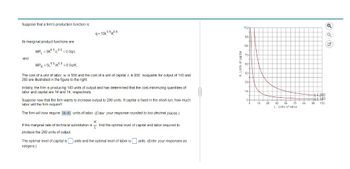
ENGR.ECONOMIC ANALYSIS
14th Edition
ISBN: 9780190931919
Author: NEWNAN
Publisher: Oxford University Press
expand_more
expand_more
format_list_bulleted
Question

Transcribed Image Text:Suppose that a firm's production function is:
q=10L0.50.5
Its marginal product functions are:
and
MPL = 5K0.5/0.5 = 0.5q/L
MPK-5L0.50.5
=0.5q/K.
The cost of a unit of labor, w, is $50 and the cost of a unit of capital, r, is $50. Isoquants for output of 140 and
280 are illustrated in the figure to the right.
Initially, the firm is producing 140 units of output and has determined that the cost-minimizing quantities of
labor and capital are 14 and 14, respectively.
Suppose now that the firm wants to increase output to 280 units. If capital is fixed in the short run, how much
labor will the firm require?
The firm will now require 56.00 units of labor. (Enter your response rounded to two decimal places.)
K
If the marginal rate of technical substitution is find the optimal level of capital and labor required to
produce the 280 units of output.
The optimal level of capital is units and the optimal level of labor is ☐ units. (Enter your responses as
integers.)
K, Units of capital
112
98-
84-
70-
56-
42-
28-
14-
0
14
28
42
56 70
84
L, Units of labor
4-280
q=140
98 112
□ □ ☑
Expert Solution
This question has been solved!
Explore an expertly crafted, step-by-step solution for a thorough understanding of key concepts.
Step by stepSolved in 4 steps with 4 images

Knowledge Booster
Learn more about
Need a deep-dive on the concept behind this application? Look no further. Learn more about this topic, economics and related others by exploring similar questions and additional content below.Similar questions
- Suppose a pizza parlor has the following production costs: $5.00 in labor per pizza, $3.00 in ingredients per pizza, $0.20 in electricity per pizza, $1,500 in restaurant rent per month, and $250 in insurance per month. Assume the pizza parlor produces 1,000 pizzas per month. What is the variable cost of production (per month)? The variable cost of production is $ (Enter your response as an integer.) What is the fixed cost of production (per month)? The fixed cost of production is $ ☐. (Enter your response as an integer.)arrow_forwardAssume there is a linear isoquant where the input combination K = 10, L = 0 produces Q = 100. Assume that this isoquant has a MRTS (marginal rate of technical substitution) such that an increase in L by 1 unit requires the firm to give up – ½ unit of K. Assume PL = $1 and PK = $1. What is the smallest total cost necessary to produce Q = 100? $20 $10 $50 $100arrow_forwardAssume there is a linear isoquant where the input combination K = 10, L = 0 produces Q = 100. Assume that this isoquant has a MRTS (marginal rate of technical substitution) such that an increase in L by 1 unit requires the firm to give up – ½ unit of K. Assume PL = $1 and PK = $1. What is the smallest total cost necessary to produce Q = 100?arrow_forward
- Suppose a firm could produce data storage services using two inputs: high capacity hard drive (200 TB) or low capacity hard drive (100 TB). What is the production function and what is a typical set of isoquant?arrow_forwardAssume there is a linear isoquant where the input combination K = 10, L = 0 produces Q = 100. Assume that this isoquant has a MRTS (marginal rate of technical substitution) such that an increase in L by 1 unit requires the firm to give up – ½ unit of K. Assume PL= $1 and PK = $1.What is the smallest total cost necessary to produce Q = 100?arrow_forwardConsider a short run production function q=5L+K, using L units of labour and K units of capital. Compute the marginal product of labour. 2. Does the production function exhibit decreasing, increasing or constant returns to scale?arrow_forward
- A firm's production function is given by Q = 20L0.8 K0.2. At that moment, the firm sets = 1,000 and K = 1,000. Which of the following combinations of L and Klies on the same isoquant? L = 1,063.9; K = 698.7 L= 1,063.9; K = 698.7 L=698.7; K = 1,063.9 L = 1,302.3; K = 936.1 L 936.1; K 1,302.3arrow_forwardSuppose a firm has the following production function Q (K, L) =K0.5 L0.4. Show mathematically whether the firm has increasing, decreasing, or constant returns to scale.arrow_forward
arrow_back_ios
arrow_forward_ios
Recommended textbooks for you

 Principles of Economics (12th Edition)EconomicsISBN:9780134078779Author:Karl E. Case, Ray C. Fair, Sharon E. OsterPublisher:PEARSON
Principles of Economics (12th Edition)EconomicsISBN:9780134078779Author:Karl E. Case, Ray C. Fair, Sharon E. OsterPublisher:PEARSON Engineering Economy (17th Edition)EconomicsISBN:9780134870069Author:William G. Sullivan, Elin M. Wicks, C. Patrick KoellingPublisher:PEARSON
Engineering Economy (17th Edition)EconomicsISBN:9780134870069Author:William G. Sullivan, Elin M. Wicks, C. Patrick KoellingPublisher:PEARSON Principles of Economics (MindTap Course List)EconomicsISBN:9781305585126Author:N. Gregory MankiwPublisher:Cengage Learning
Principles of Economics (MindTap Course List)EconomicsISBN:9781305585126Author:N. Gregory MankiwPublisher:Cengage Learning Managerial Economics: A Problem Solving ApproachEconomicsISBN:9781337106665Author:Luke M. Froeb, Brian T. McCann, Michael R. Ward, Mike ShorPublisher:Cengage Learning
Managerial Economics: A Problem Solving ApproachEconomicsISBN:9781337106665Author:Luke M. Froeb, Brian T. McCann, Michael R. Ward, Mike ShorPublisher:Cengage Learning Managerial Economics & Business Strategy (Mcgraw-...EconomicsISBN:9781259290619Author:Michael Baye, Jeff PrincePublisher:McGraw-Hill Education
Managerial Economics & Business Strategy (Mcgraw-...EconomicsISBN:9781259290619Author:Michael Baye, Jeff PrincePublisher:McGraw-Hill Education


Principles of Economics (12th Edition)
Economics
ISBN:9780134078779
Author:Karl E. Case, Ray C. Fair, Sharon E. Oster
Publisher:PEARSON

Engineering Economy (17th Edition)
Economics
ISBN:9780134870069
Author:William G. Sullivan, Elin M. Wicks, C. Patrick Koelling
Publisher:PEARSON

Principles of Economics (MindTap Course List)
Economics
ISBN:9781305585126
Author:N. Gregory Mankiw
Publisher:Cengage Learning

Managerial Economics: A Problem Solving Approach
Economics
ISBN:9781337106665
Author:Luke M. Froeb, Brian T. McCann, Michael R. Ward, Mike Shor
Publisher:Cengage Learning

Managerial Economics & Business Strategy (Mcgraw-...
Economics
ISBN:9781259290619
Author:Michael Baye, Jeff Prince
Publisher:McGraw-Hill Education